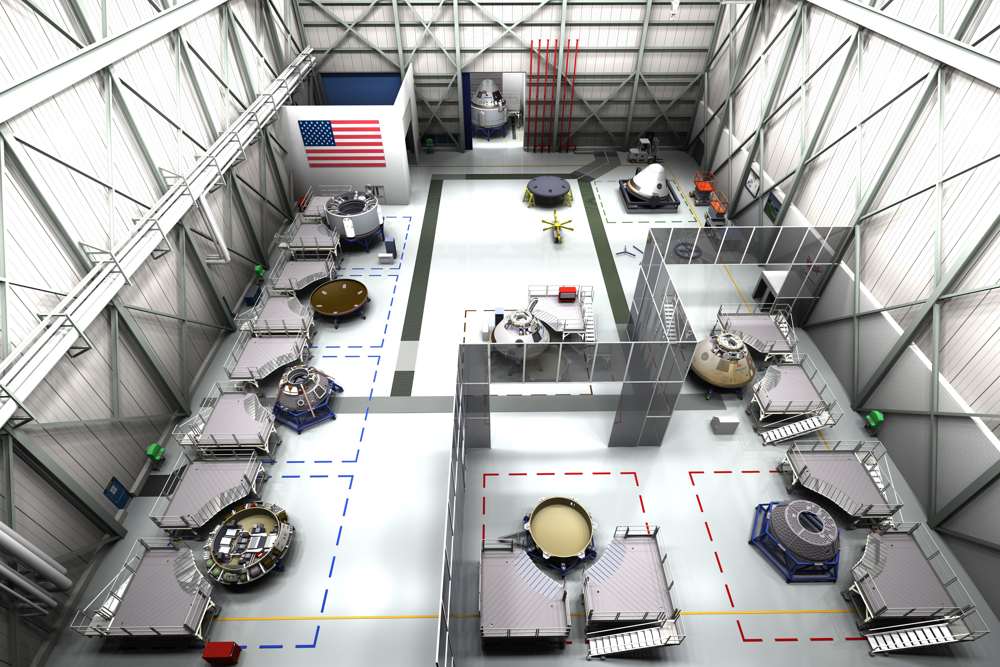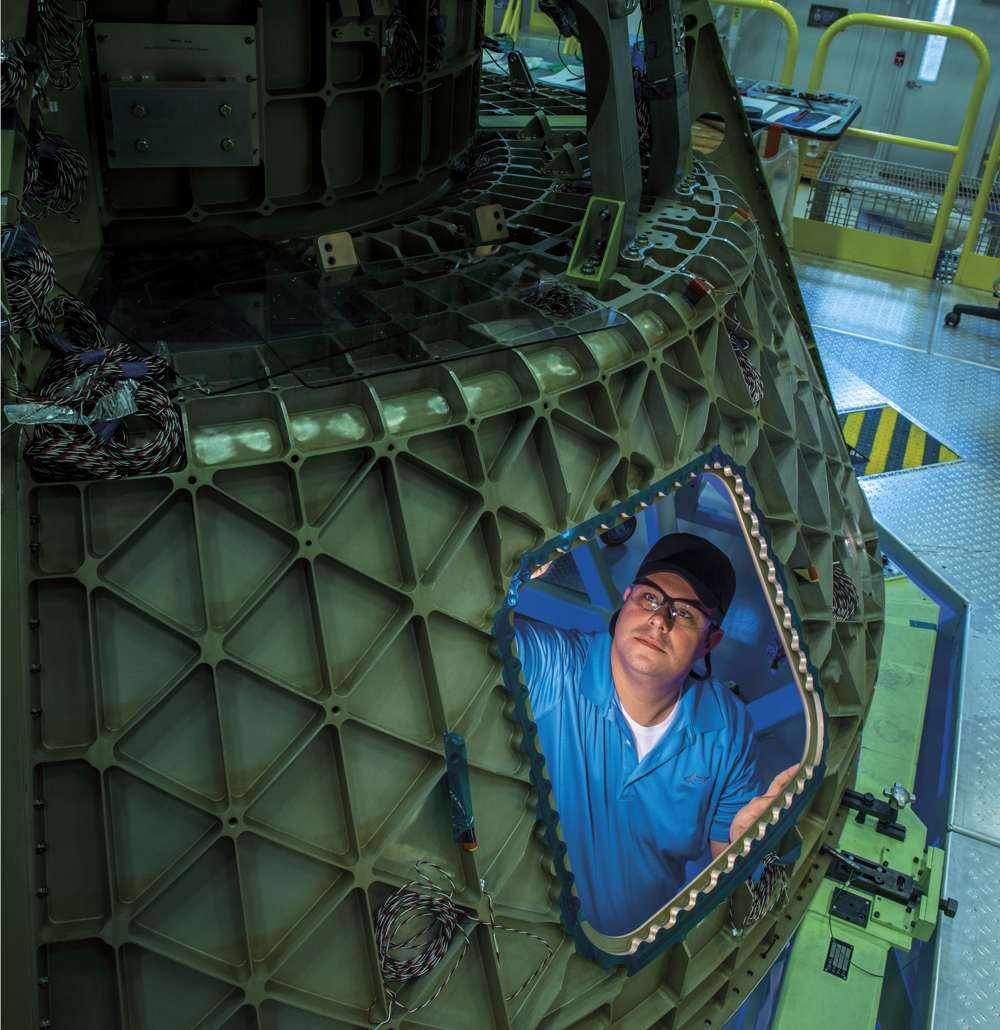Building a better spaceship

Welding would seem to be a necessity for a spacecraft, but Boeing’s Starliner will carry four astronauts to and from the International Space Station up to 10 times, while only bolted together.
Building a crewed spaceship has always been the domain of governments, but since 2009 NASA has been seeking to turn access to low Earth orbit over to private companies and in a former Space Shuttle hanger at Kennedy Space Centre, one of the new commercial spacecraft for ferrying astronauts to the International Space Station (ISS) is being built.
“We have three [Crew Space Transportation-100] Starliner crew modules in production now,” said Boeing. Those three Starliners are called Spacecraft 1, Spacecraft 2 and Spacecraft 3.
Boeing’s Crew Space Transportation (CST) 100 Starliner is designed to be reusable and take seven passengers, or a mix of crew and cargo, to low-Earth orbit. NASA is paying Boeing to supply six missions to and from the ISS and two test flights. The six missions will transport four astronauts and ISS science research. The first test flight will send Spacecraft 3 to the ISS without a crew and the second, using Spacecraft 2, will have a crew of at least two. NASA is evaluating if it wants a third crew member on that flight. The Starliner will land on land using air bags and there are five designated landing sites in the Western United States. All of NASA’s previous capsules Mercury, Gemini and Apollo, in the 1960s and 1970s, all returned to the sea.
The two Starliners, Spacecraft 2 and 3, in production now will have their crew modules refurbished to fly the astronauts to the ISS after the tests. Spacecraft 1, “will be used for the pad abort test. The other two will be used for both flight tests and then turned around for all six of our contracted NASA operational missions,” explained Boeing. The pad abort test will take place at White Sands, New Mexico, and is expected to occur before September. In January, NASA stated that Boeing's orbital flight test will take place in August and then its crew flight test will occur in November.
Asked if the August date was still likely, Boeing told Aerospace Manufacturing: “Boeing is working with NASA to ensure that the CST-100 Starliner flies at the earliest time it is safe to do so.”

The production of the three CST-100s largely takes place in what is now called the Commercial Crew and Cargo Processing Facility (C3PF). The C3PF is for final assembly, integration and testing. This work is carried out at what Boeing calls ‘footprints’, which are the C3PF’s stations. Boeing declined to state what final assembly operations occur at each of the footprints, eleven of which can be seen in the C3PF concept art. Previously, the C3PF was a Space Shuttle hangar. Prior to final assembly, Boeing factories and suppliers across the USA support Starliner construction by producing the components and sub-systems and carry out their testing.
The C3PF has a low bay and a high bay. The CST-100 service modules are assembled in the low bay, which was previously the Space Shuttle Main Engine Shop. While the Starliner’s crew module is refurbished, a new service module is built for every mission as they are expendable. Each one burns up on re-entry. The service module is covered in the solar cells that provide electricity for the spacecraft. The cells are incorporated into the micro-meteoroid debris shield. Spectrolab in Sylmar, California, is supplying more than 3,500 solar cells for each Starliner.
The service module also contains the launch abort motors that would propel the Starliner away from a malfunctioning rocket during launch and ascent. Starliner is launched on a United Launch Alliance Atlas V rocket.
The crew modules for the astronauts are being assembled in the high bay, which was where the Shuttle would be processed before its next flight. Both bays have what are called clean room areas necessary for human spaceflight. In the C3PF’s clean rooms, the parachutes, solar arrays, seat pallet and avionics are installed.
Down to final assembly
Final assembly begins with the crew module’s pressure shell. The shell is made from an aerospace grade aluminium alloy and comes in two parts. It has an upper and a lower dome. The manufacturing of the domes begins with cylindrical forging then a weldless spin forming process finishes the basic shape. Spincraft based in North Billerica, Massachusetts, performs the spin-form work.
The aluminium upper and lower domes then have a honeycomb pattern machined into them to reduce their weight while preserving their strength, so they can handle the flight stresses. The honeycomb pattern requires 1,500 of what Boeing calls, ‘pockets’, to be machined into the lower dome and they require hundreds of hours. Janicki Industries in Layton, Utah, machines the lower domes and Major Tool & Machine in Indianapolis machines the upper dome.
Once the domes are completed they are bolted together as, Boeing says, welding weakens the structure. The domes also come together initially for a leak and pressure test. Boeing said: “There are various methods for inspecting the pressure vessels, including laser inspection and pressure proof testing.” The domes have 216 bolts which once inserted and tightened are allowed to settle for three days (due to the region’s temperature and humidity factors) before being tightened again to a specific torque. The air tight seal that is created between these two domes is called ‘Gasko-seals’, by Boeing. The first CST-100 Starliner hull was completed by May 2016.

This Gasko-seal is a derivative of the ISS’s common berthing mechanism. The common berthing mechanism is how the pressurised modules of the ISS attach to each other. Boeing said that this approach allows it, “to populate the wiring, tubing [and] avionics on the domes separately, which is significantly more efficient than having to bring all of this hardware into the vehicle through the hatch.” The sub-systems are installed into each dome before the two come together.
Other examples of work done at the footprints are the installation of the astronauts’ seats and the NASA Docking System (NDS). The astronauts’ seats are fixed to a large component called the seat pallet which can hold five seats, despite there being four astronauts. Prior to its installation the pallet’s construction requires more than 400 holes to be drilled. Boeing declined to say how exactly the seat pallet is fabricated. The NDS is part of the upper dome and in June this year Boeing had two NDS at the C3PF. One of those NDS was installed in Spacecraft 2 and the other in Spacecraft 3. The NDS docks with the Boeing-built international docking adapter already at the ISS.
Reach for the stars
Boeing has built various Starliners for different test purposes. It has three of what it calls boiler plate or BP test articles. They simulate the dimensions and weight of the Starliner and have been used for parachute, airbag and water recovery tests. Boeing also has a structural test article which has acted as an engineering pathfinder to verify the manufacturing methods, materials and parts in the C3PF. The structural test article was also shipped to Huntington Beach, California for critical load condition tests and structural integrity and shock level testing. The performance of the system that will separate the crew module from the service module was also tested.
Other testing for the CST-100 has included, electronic interference and thermal and vacuum chambers where its ability to withstand the rigours of spaceflight in the hazardous environment of low-Earth orbit is evaluated.
“Creating a new, human-rated spacecraft presents many unique challenges during the design, production, testing and validation phases. As we move through the development of the Starliner, we continue to mitigate risks,” Boeing said.
Once the Starliner is in operation the C3PF will refurbish them for their next flight. When Spacecraft 2 and 3 come back from their missions they will have a six-month turnaround time between their flights. With six missions, each spacecraft should have three ISS return flights. While the crew module is reusable, the ascent cover, forward heat shield, base heat shield, parachutes and landing air bags are all replaced after each mission. Boeing declined to say how either the heat shield on the capsule’s base or the forward heat shield that is the thermal protection material on the upper part of the crew module is attached. Boeing did not disclose which servicing activities are carried out at which footprint.
The final countdown

The ISS has a crew of six. Today, all six are transported to the station by Russian Soyuz spacecraft with three astronauts launched every three months. When Starliner starts flying Soyuz will only have to launch twice a year and the ISS crew will increase to seven, making the station more productive. The space station is expected to operate until 2025 at least, at which point private enterprise is expected to begin taking over the running of research facilities in low-Earth orbit. Whether that is a privatised ISS or entirely new commercially launched space stations, Boeing is looking ahead to more customers for its CST-100.
“As new missions, new customers and new destinations come online, we could build additional crew [and service] modules to support that.”











